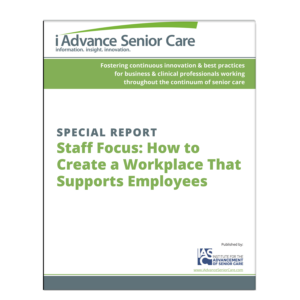2015 Business Outlook: Staffing
Editor's Note: Senior housing and services providers will enter 2015 with many unanswered questions regarding their future. A new Republican majority in the U.S. Senate, an expanded Republican majority in the U.S. House of Representatives and the presence of Republican governors in more states will bring new perspectives to the political landscape. Controversial presidential executive orders related to immigration reform await resolution, and threatened governmental action could overturn some or all of the Affordable Care Act and the health insurance it provides to certain seniors and others. New payment models and regulations under consideration could alter the business climate for years to come. In this multi-part series, Long-Term Living takes a look at some of the top issues that those who serve older adults will face in the new year. This is part four. See the entire series here, or see the digital edition of the December 2014 issue for the print version of these and related articles.
The very youngest members of the Baby Boom, the generation that represents about one-third of the U.S. population, turn 50 Dec. 31. By 2050, the number of Americans needing long-term can will more than double, from 12 million to 27 million, notes the National Council on Aging. The country’s aging population, and its concurrently aging workforce, will make it more difficult for providers to recruit, replace and maintain workers just when their services will be in highest demand.
Some contend that the immigration reforms announced by President Barack Obama on Nov. 20—protecting as many as five million undocumented immigrants from deportation and giving work permits to some—would help increase the pool of legal workers available in the United States, potentially benefitting skilled nursing and other facilities serving older adults. The American Health Care Association (AHCA), for one, has advocated for immigration reform, testifying before Congress in March 2013 and calling for efforts to make it easier for immigrants to be legally employed.
Beyond immigration reform, however, aging services providers must find ways to address the staff-related challenges they face. National turnover rates for CNAs, LPNs and RNs working in nursing homes, assisted living communities and continuing care retirement communities average 25 to 35 percent, according to data from the Hospital and Healthcare Compensation Service. RNs average hourly pay rates in the upper $20s, LPNs in the lower $20s and CNAs in the lower to mid $10s, according to the service.
Long-term care employees responding to a recent Shriver Report poll said that the most helpful actions employers could take would be increasing pay and benefits, providing up to 10 days of paid time off to cover sickness in themselves or a family member, and providing paid time off after the birth of a child, to care for a seriously ill family member or to recover from their own serious illness.
 “If we don’t do something to attract and retain people for the future, then the direct care workers, especially, are going to be in short supply and high demand,” says Larry Minnix, president and CEO of LeadingAge. The organization, he adds, has advocated for living wages, good benefits and development opportunities for workers—and reimbursement to cover them. “Seventy percent or so of our costs in nursing home care are people,” he says. “And staffing is still the best proxy for quality. So we have advocated for policy that will directly reimburse us for those costs.”
“If we don’t do something to attract and retain people for the future, then the direct care workers, especially, are going to be in short supply and high demand,” says Larry Minnix, president and CEO of LeadingAge. The organization, he adds, has advocated for living wages, good benefits and development opportunities for workers—and reimbursement to cover them. “Seventy percent or so of our costs in nursing home care are people,” he says. “And staffing is still the best proxy for quality. So we have advocated for policy that will directly reimburse us for those costs.”
The work is hard but rewarding, Minnix says. A program for staff members similar to the National Health Service Corps program, which repays loans and provides scholarships to primary care providers and students who serve in rural or inner-city neighborhoods, would “incentivize people to come into our field for two years or five years and give us a try. If we get someone for six months, we’ve got a good chance to keep them for life. They make a career out of it,” he says.
 Staff continuity is important to implementing and maintaining best practices as well as helping providers maximize the investment they’ve made in recruiting and training workers, says Len Russ, chair of AHCA, who also has the perspective of an owner; he is the principal partner of Bayberry Health Care, a New York-based partnership specializing in skilled nursing, subacute and in-patient short-term rehabilitative care, and also is co-owner of Aaron Manor Nursing and Rehabilitation in Rochester, NY. Citing the same estimate as Minnix, that staff members account for 70 percent of costs, Russ says AHCA is “in favor of paying them as much as possible within the context of the budgetary restraints that we’re put under.”
Staff continuity is important to implementing and maintaining best practices as well as helping providers maximize the investment they’ve made in recruiting and training workers, says Len Russ, chair of AHCA, who also has the perspective of an owner; he is the principal partner of Bayberry Health Care, a New York-based partnership specializing in skilled nursing, subacute and in-patient short-term rehabilitative care, and also is co-owner of Aaron Manor Nursing and Rehabilitation in Rochester, NY. Citing the same estimate as Minnix, that staff members account for 70 percent of costs, Russ says AHCA is “in favor of paying them as much as possible within the context of the budgetary restraints that we’re put under.”
Some providers, he notes, subsidize education and accommodate the schedules of nurses’ aides who wish to become LPNs and LPNs who wish to become RNs. “AHCA and our state associations also provide scholarship money to do that,” Russ says. “I think the important thing is to make sure there’s a career pathway to elevate yourself within our sector, so you don’t need to leave the sector to move up the economic ladder or the professional ladder.”
Providers and other staff members benefit from such practices, he says. “Not only does it show [workers] a career ladder; it also gives them a degree of insight that you don’t have if you just come in at a middle- or a high-level professional level. They know what it’s like hands-on from the ground up. And they also know the people they’re supervising, the challenges they face every day.”
Another effort to improve the jobs of nursing home assistants, home health aides and personal care aides is the Paraprofessinal Healthcare Institute’s ongoing five-year philanthropic campaign to raise $9 million. The goal, ultimately, is to improve the quality of care delivered in nursing homes, community-based settings and homes.
And a presidential executive order announced in conjunction with the signing of the Improving Medicare Post-Acute Care Transformation Act in September may result in more uniform staffing throughout the year. In an effort to make more accurate information available to consumers via the Centers for Medicare & Medicaid Services’ Nursing Home Compare website, the order requires providers to submit year-round, automated payroll data rather than self-reported data.
 “One of the ways to game the quality measures that were publicly reported was to beef up your staff just a few weeks before survey and then go back down to lower staffing afterwards,” notes Cheryl Phillips, MD, senior vice president of public policy and advocacy for LeadingAge. The new reporting requirement, she says, “will give better information for…seniors and their families as they select nursing homes, it will give better information about the needs of the individuals served, and it will give better information as to what…we [are] paying for when we send people to various settings.”
“One of the ways to game the quality measures that were publicly reported was to beef up your staff just a few weeks before survey and then go back down to lower staffing afterwards,” notes Cheryl Phillips, MD, senior vice president of public policy and advocacy for LeadingAge. The new reporting requirement, she says, “will give better information for…seniors and their families as they select nursing homes, it will give better information about the needs of the individuals served, and it will give better information as to what…we [are] paying for when we send people to various settings.”
 Clif Porter, senior vice president of government relations for AHCA, says the organization supports the new requirement because surveyors already were validating staffing levels via payroll records. As a former 16-year nursing home administrator, he says he is bothered that some assume all operators are being “nefarious” and trying to “cheat the system.” “Everyday operators, they don’t think about that,” Porter says. “They have to take care of patients, they have to be sure they’re staffed, they have to make sure that patients are changed and turned and fed and rehabbed. That all by itself is an all-consuming task every day.”
Clif Porter, senior vice president of government relations for AHCA, says the organization supports the new requirement because surveyors already were validating staffing levels via payroll records. As a former 16-year nursing home administrator, he says he is bothered that some assume all operators are being “nefarious” and trying to “cheat the system.” “Everyday operators, they don’t think about that,” Porter says. “They have to take care of patients, they have to be sure they’re staffed, they have to make sure that patients are changed and turned and fed and rehabbed. That all by itself is an all-consuming task every day.”
Also in this series:
2015 Business Outlook: Payment
2015 Business Outlook: Service Reach
2015 Business Outlook: Quality
2015 Business Outlook: Professionalism
2015 Business Outlook: Technology
2015 Business Outlook: Important dates
Related content:
Making direct care more appealing
Post-acute care groups applaud passage of IMPACT Act
Direct care worker campaign raises $34 million
I Advance Senior Care is the industry-leading source for practical, in-depth, business-building, and resident care information for owners, executives, administrators, and directors of nursing at assisted living communities, skilled nursing facilities, post-acute facilities, and continuing care retirement communities. The I Advance Senior Care editorial team and industry experts provide market analysis, strategic direction, policy commentary, clinical best-practices, business management, and technology breakthroughs.
I Advance Senior Care is part of the Institute for the Advancement of Senior Care and published by Plain-English Health Care.
Related Articles
Topics: Articles , Staffing











